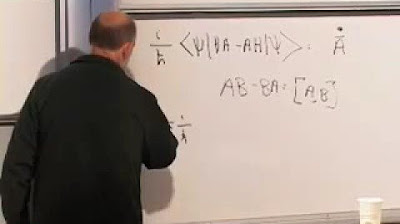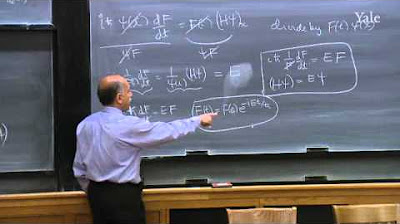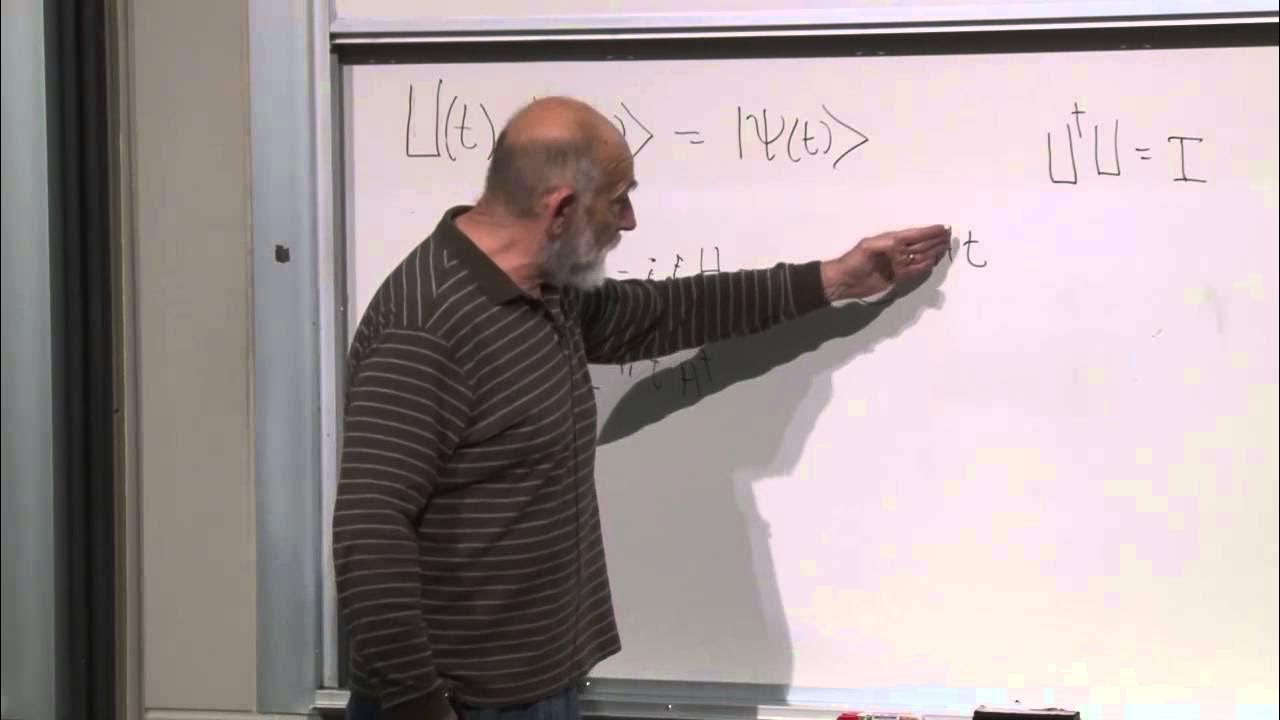Lecture 4 | The Theoretical Minimum
TLDRThe video script is a detailed lecture on quantum mechanics, focusing on the principles and mathematical formulations that underpin the theory. The lecturer revisits the postulates of quantum mechanics, emphasizing the role of observables, Hermitian operators, and the concept of physically distinguishable states. They delve into the measurement problem and the famous double-slit experiment, illustrating the probabilistic nature of quantum mechanics versus the determinism of classical physics. The principle of superposition and the collapse of the wave function upon measurement are also discussed. Mathematically, the lecture introduces the Hamiltonian, a Hermitian operator representing the total energy of the system, and derives the time-dependent Schrödinger equation, which describes how quantum states evolve over time. The lecturer further explores the expectation value of an observable and its relation to the Hamiltonian, highlighting the conservation of energy in quantum systems. The content is rich in quantum theory, requiring a foundational understanding of physics and mathematics to fully appreciate the nuances of the discussion.
Takeaways
- 📚 The four principles of quantum mechanics discussed are: observables as Hermitian operators, physically distinguishable states, the probability principle (Born's Rule), and the time evolution of quantum states.
- 🌟 Observables in quantum mechanics are represented by Hermitian operators, and their eigenvalues represent the possible numerical values that can be measured.
- 📊 Physically distinguishable states are those that can be differentiated through some measurement process, and they are represented by orthogonal vectors.
- 🎯 The probability of obtaining a particular outcome (eigenvalue) when measuring an observable is given by the square of the inner product of the state vector with the corresponding eigenvector, as per Born's Rule.
- ⏱️ The time evolution of a quantum state is governed by a linear operator, which is unitary, ensuring the conservation of the inner product (and hence, the conservation of probability).
- 🔍 The Hamiltonian operator, which generates the time evolution of quantum states, is Hermitian and represents the total energy of the system.
- 🤔 The concept of energy conservation in quantum mechanics is discussed in the context of the average value (expectation value) of the Hamiltonian remaining constant over time if the Hamiltonian is time-independent.
- 🧮 The commutator of the Hamiltonian with another observable plays a crucial role in determining how the expectation values of observables change over time.
- 📓 The script touches upon the need to include the apparatus in the quantum system when measurements are made, highlighting the holistic nature of quantum state evolution.
- 🔗 A deeper connection between quantum mechanics and classical mechanics is suggested through the similarity between Poisson brackets and commutators, with the latter being a small correction to the former in the context of large quantum numbers.
- 📈 The expectation value of an observable can be used to derive equations of motion for average values, which under certain conditions, resemble classical equations of motion.
Q & A
What are the four principles of quantum mechanics mentioned in the transcript?
-The four principles mentioned are: 1) Observables are represented by Hermitian operators. 2) Physically distinguishable states are represented by orthogonal vectors. 3) The results of experiments are always real numbers. 4) The probability principle, also known as Born's Rule, which calculates probabilities for various experimental outcomes.
What is the significance of Hermitian operators in quantum mechanics?
-Hermitian operators are significant because they represent observables in quantum mechanics. Every observable is identified with a Hermitian operator, and their eigenvalues represent the possible numerical values that can be measured.
What does it mean for two states to be physically distinguishable in quantum mechanics?
-Two states are physically distinguishable if there exists a measurement that can tell the difference between them. This means that an experiment can unambiguously determine which of the two states is being observed.
Why are the eigenvalues of a Hermitian operator always real numbers?
-The eigenvalues of a Hermitian operator are always real numbers because they represent the possible outcomes of an experiment. If the eigenvalues were complex, they would imply that two independent things were measured, which is not the case for a single observable.
What is Born's Rule and how is it used in quantum mechanics?
-Born's Rule is a principle that allows for the calculation of probabilities in quantum mechanics. It states that the probability of obtaining a particular eigenvalue when measuring an observable is equal to the square of the inner product of the system's state vector with the corresponding eigenvector.
How does the Hamiltonian operator relate to the evolution of quantum states over time?
-The Hamiltonian operator, which is Hermitian, governs the evolution of quantum states over time. It is used in the time-dependent Schrödinger equation to describe how the state vector of a quantum system changes with time.
What is the role of the Hamiltonian in quantum mechanics?
-The Hamiltonian operator in quantum mechanics is associated with the total energy of the system and is responsible for the time evolution of the state vector. It generates the changes in the state vector as described by the Schrödinger equation.
Why is the Hamiltonian operator required to be Hermitian?
-The Hamiltonian operator must be Hermitian to ensure that its eigenvalues, which represent the possible results of measurements of the energy, are real numbers. This is a requirement for physical observables in quantum mechanics.
What is the conservation of overlap principle in quantum mechanics?
-The conservation of overlap principle states that the inner product between two state vectors remains constant with time if those state vectors evolve according to the same unitary operator. This principle is a consequence of the unitarity of quantum mechanical time evolution.
What is the difference between the expectation value and the actual values that might be obtained from a quantum measurement?
-The expectation value is a weighted average of all possible outcomes, each outcome multiplied by its probability of occurrence. It is not the same as the actual values that might be obtained from a single measurement, which are the eigenvalues of the corresponding observable.
How does the concept of entanglement relate to the measurement process in quantum mechanics?
-Entanglement is a phenomenon in quantum mechanics where the state of one system becomes dependent on the state of another system, even when they are separated by large distances. The measurement process can lead to entanglement between a quantum system and a measuring apparatus, which is crucial for understanding the collapse postulate.
What is the connection between the commutator of two operators and the Poisson bracket in classical mechanics?
-The commutator of two operators in quantum mechanics, [H, L] = HL - LH, is analogous to the Poisson bracket of the corresponding classical quantities. The Poisson bracket is related to the commutator by the equation {L, H} = -iħ[L, H], where ħ is the reduced Planck constant.
Outlines
📘 Introduction to Quantum Mechanics Principles
The paragraph introduces the foundational principles of quantum mechanics. It discusses observables and their representation by Hermitian operators, the concept of physically distinguishable states, and the Born rule for calculating probabilities. The speaker emphasizes the importance of these principles in quantum mechanics and hints at revisiting the spin system later in the lecture.
📑 Distinguishability and Representation of States
This section delves into the concept of physically distinguishable states and how they are represented by orthogonal vectors in quantum mechanics. It also touches on the nature of experimental outcomes and the role of real numbers in representing these outcomes. The paragraph further explains the probability principle, also known as Born's rule, and how it is used to calculate the probabilities of different experimental results.
🧮 The Born Rule and Probability Amplitudes
The paragraph focuses on the Born rule and its significance in quantum mechanics for predicting probabilities of various experimental outcomes. It clarifies the concept of probability amplitudes and why the square of the absolute value of the inner product is used to compute probabilities. The discussion also addresses the justification of quantum mechanics principles through experimental validation.
📐 The Theorem of Orthonormal Eigenvectors
The speaker presents a theorem that discusses the properties of eigenvectors corresponding to a Hermitian operator. The theorem states that eigenvectors with different eigenvalues are orthogonal, and those with the same eigenvalue can be chosen to be orthogonal through linear combinations. This leads to the conclusion that the eigenvectors of a Hermitian operator can form an orthonormal basis.
🕰 Time Evolution and the Schrödinger Equation
This part of the script introduces the concept of time evolution in quantum mechanics. It discusses how states change over time and presents the idea of a time-development operator, which is linear and operates on the initial state to produce the state at a later time. The paragraph also covers the principle of conservation of overlap and its implications for the evolution of quantum states.
🔍 The Hamiltonian and Quantum State Evolution
The paragraph explores the Hamiltonian operator, which governs the time evolution of quantum states. It explains that the Hamiltonian is a Hermitian operator and is associated with the energy of the system. The discussion also involves the derivation of the time-dependent Schrödinger equation, which describes how quantum states evolve over time, and the importance of understanding the Hamiltonian for this evolution.
🎭 The Role of Measurement in Quantum Systems
The speaker touches on the role of measurement in quantum mechanics and the need to include the apparatus that interacts with the system as part of the system itself. The paragraph emphasizes that the evolution described by the Schrödinger equation applies to isolated systems and that the impact of measurements on state evolution will be addressed in future lectures.
🔗 Expectation Values and Quantum-Classical Analogy
This section introduces the concept of expectation values in quantum mechanics, which, despite the name, often represent the average value of a quantity rather than what is expected from an experiment. The speaker also discusses the connection between quantum mechanics and classical mechanics through expectation values and how they evolve over time, drawing parallels with classical physics.
🔄 Commutators, Poisson Brackets, and Energy Conservation
The paragraph discusses the relationship between commutators in quantum mechanics and Poisson brackets in classical mechanics. It highlights the formal similarity between the two and suggests a connection through a constant (Planck's constant). The speaker also addresses energy conservation in quantum mechanics, showing that the average value of the Hamiltonian remains constant over time, indicating a conservation principle.
📝 Summary and Future Directions
The speaker summarizes the key points covered in the lecture, including the principles of quantum mechanics, the role of the Hamiltonian, and the concept of expectation values. The paragraph concludes with a teaser for future lectures, which will delve deeper into the collapse postulate, entanglement, and further connections between quantum and classical mechanics.
Mindmap
Keywords
💡Observables
💡Hermitian Operators
💡Eigenvalues and Eigenvectors
💡Physically Distinguishable States
💡Orthogonality
💡Born Rule
💡
💡Probability Amplitude
💡Unitary Operator
💡Hamiltonian
💡Time-Dependent Schrödinger Equation
💡Expectation Value
Highlights
Introduction of the four principles of quantum mechanics and the intention to discuss a fifth, emphasizing their interdependence.
Defining observables as measurable quantities in quantum mechanics, represented by Hermitian operators.
Eigenvalues of a Hermitian operator represent the possible numerical values that can be observed upon measurement.
Discussion on physically distinguishable states and their ability to be differentiated through certain measurements.
The postulate that physically distinguishable states are represented by orthogonal vectors in quantum mechanics.
The results of quantum experiments are always real numbers, leading to the identification of observables as Hermitian operators.
Introduction of the probability principle, or Born's Rule, for calculating the probabilities of different experimental outcomes.
Explanation of how the square of the inner product of state vectors with eigenvectors gives the probability of obtaining a certain outcome.
The Hamiltonian operator, representing the total energy of the system, governs the time evolution of quantum states.
Unitary operators ensure the conservation of information and distinguishability in quantum state evolution.
Derivation of the time-dependent Schrödinger equation, which describes how quantum states change over time.
The importance of the Hamiltonian being Hermitian for the conservation of probability in a quantum system.
Discussion on the expectation value of an observable and its significance in quantum mechanics.
The average value, or expectation value, is defined as the sum over all possible outcomes weighted by their probabilities.
The connection between the commutator of two operators and the Poisson bracket from classical mechanics.
The principle of energy conservation in quantum mechanics, where the average energy of a system remains constant over time if the Hamiltonian is time-independent.
The role of Planck's constant in connecting quantum mechanics with classical mechanics through the commutator and Poisson bracket relationship.
Transcripts
5.0 / 5 (0 votes)
Thanks for rating:





